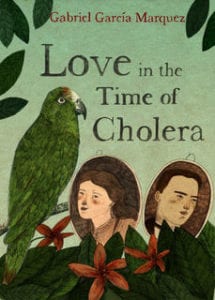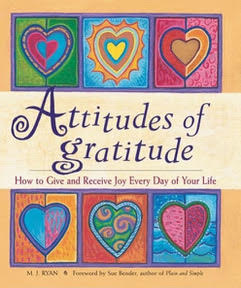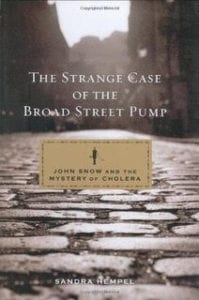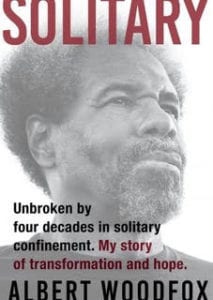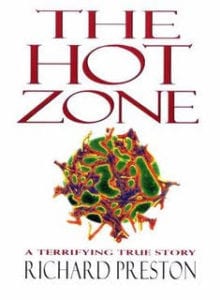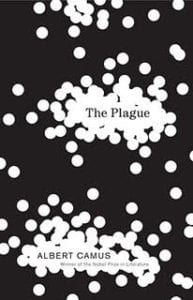April 1, 2020 | By Margo Hammond
Feeling Isolated? With Books, You Can Be Surrounded by People Again — Although Some of Them May be Zombies
. . .
“But what does it mean, the plague? It’s life, that’s all.”
The Plague by Albert Camus
. . .
Feeling isolated? Grab a book and be surrounded by people again.
Readers usually think of themselves as naturals at social distancing. We are always looking for ways to avoid company and carve out personal space to lose ourselves in a book, to finish that next chapter. Ironically, books may be the ultimate social contact.
“I don’t feel so alone in my home,” National Endowment of the Arts Literary Arts Director Amy Stolls points out in an NEAarts podcast with producer Josephine Reed. “I’m looking at my bookshelf. I’m amidst a lot of characters right here.”
But what should we read in this time of forced quarantine? Do we read books that comfort and lift up our spirits? Or do we read scary books on the theory that reading about worst-case scenarios will help us see our situations as not so bad after all?
Personally, I always have liked to mix up my reading — some fiction and non-fiction, some high brow and low brow — and during this time of confinement, it has been no different.
On the comforting side, every night I’ve been reading a passage from Attitudes of Gratitude: How to Give and Receive Joy Every Day of Your Life by M.J. Ryan (she of Random Acts of Kindness fame). It was a gift from my college roommate who was visiting Florida from Ohio just before we all went into lockdown. We always exchange books when we meet. I gave her Jenny Offfill’s Weather, a perfect novel for bibliophiles — it’s narrated by a librarian.
During the day, on the other hand, I find myself gravitating toward gloomier titles. Books of non-fiction, in particular, that address past epidemics and how the world handled them. Books like The Strange Case of the Broad Street Pump: John Snow and the Mystery of Cholera by Sandra Hempl and Flu: The Story of the Great Influenza Pandemic of 1918 and the Search for the Virus That Caused It by Gina Kolata, the senior medical writer for the New York Times.
Hempl tells the empowering story of how one impoverished doctor — working alone and without recognition — solved the riddle of what was causing the deadly cholera epidemics killing millions. He simply mapped out the cases in his London neighborhood and figured out that they all led back to a common well — the Broad Street pump of the title — used for their drinking water. The cholera was in the water, not the air, as had been commonly believed. His discovery laid the groundwork for today’s scientific approach to pandemics.
Kolata’s story, about a pandemic that claimed 50 million lives worldwide, took place not that long ago. I wasn’t alive but my mother was — she was five. My grandmother’s actions during the epidemic are a source of family pride. When all the members of a Danish family next door came down with the flu, no one would enter their house except my grandmother who brought them soup, changed their bedsheets and scrubbed down their surroundings. They credited her with saving their lives. To thank her, the Danish mother gave my grandmother a pink scalloped dish engraved with the words God Bess You in Danish which now sits in a glass display cabinet in my home.
Books about other people’s problems and how they coped with them can put this time of social distancing in perspective, says Jason Rezaian. An Iranian-American journalist, Rezaian learned how to make the best of a time in isolation the hard way — from 2014-2015, he was held for 544 days in Iran’s Evin Prison, including 49 in solitary.
“After I was released from solitary confinement, I was allowed some small privileges. The one that I quickly realized was the most indispensable was access to books,” he explains in a Washington Post op ed titled “I survived solitary confinement. You can survive self-isolating.”
“Reading was a wonderful mental escape from my grim surroundings,” writes Rezaian. “It also connected me to the outside world. I found myself gravitating toward books about hardship. They demonstrated for me that my experience, no matter how difficult, was one that I could survive.”
The book he read over and over was Aleksandr Solzhenitsyn’s The Gulag Archipelago, Solzhenitsyn’s own memoir of imprisonment in Soviet prison camps. He said Solzhenitsyn’s memoir of his imprisonment in Soviet prison camps turned out to be “surprisingly soothing.”
“Suddenly I didn’t feel so sorry for myself,” says Rezaian.
Many of the lists I’ve seen recommending books to read during this time of coronavirus quarantine seem to align with this reasoning: The scarier books often outweigh the more comforting titles.
Out of 30 titles picked by Time Magazine for its list of “30 Books and Series to Read While Social Distancing,” nine are about pandemics and post-apocalyptic worlds and seven are about solitude. Under the books about solitude there is the story of a man who is condemned to live out his life in the confines of a hotel (The Gentleman in Moscow by Amos Towles) and another of a man who is left behind to die on Mars (The Martian by Andy Weir, which was made into a movie starring Matt Damon). And those are just the fictional ones.
The true life stories on the list are far more harrowing: In Wave, Sonali Deraniyagala writes about recovering from losing her entire family in a tsunami. In Wild (also made into a movie starring Reese Witherspoon) Cheryl Strayed takes a 1,100-mile solo hike along the Pacific Crest Trail to confront her drug addiction, her broken marriage and her grief over her mother’s death. In Solitary Albert Woodfox describes how he endured solitary confinement for four decades for a crime he says he didn’t commit.
The books that Time magazine recommends under the heading “Pandemics and Post-Apocalyptic Worlds,” novels that “take you inside imagined crises and the resilient characters who face them,” aren’t any cheerier. Justin Cronin’s The Passage Trilogy (an post-apocalyptic tale about a secret government project gone wrong); M.K. Jemisin’s The Broken Earth (a dystopian fantasy); Gabriel Garcia Marquez’s Love in the Time of Cholera (which is not so much about cholera as it is about the disease of lovesickness); Peng Sheperd’s The Book of M (about a plague that steals people’s shadows) and Colson Whitehead’s Zone One (a zombie novel, says Time, that blends “literary fiction, humor and horror”).
Hitting even more close to home is Max Brooks’ World War Z, a novel written in 2006 (and made into an action movie starring Brad Pitt in 2013) about a virus that started in China and spread across the world transforming millions into zombies. Okay, so we probably won’t be dealing with zombies this time around, but how about this for a prescient plot twist? The Chinese try to cover up the news of the virus and the U.S., in an election year, is slow to respond to the danger.
The book, not surprisingly, was banned in China, but in this telling it’s not the virus or even the zombies that are threats to civilization — but the denial and panic they cause.
Those who naturally enjoy reading (and watching movies) about chaos and mayhem (I’m looking at you, Game of Thrones and The Hunger Games fans) will appreciate the list offered by The Portalist, a sci fi and fantasy site — “16 Alarming Books About Apocalyptic Plagues,” promising that these “terrifyingly realistic books will make you want to live in a bubble — permanently.” They include novels by such classic sci fi and horror writers as Octavia Butler (Clay’s Ark), Mary Shelley (The Last Man), Jack London (The Scarlet Plague) and Michael Crichton (The Andromeda Strain). Also on the list is The Stand, a novel by the king of horror Stephen King about a mutated strain of the flu that kills 99 percent of the population.
The Stand, in fact, was so widely evoked when lockdowns began that King felt obliged to proclaim on Twitter that “No, coronavirus is NOT like THE STAND. It’s not anywhere near as serious. It’s eminently survivable.” Last week, King suggested that people might want to read Chapter 8 though, to learn how coronaviruses work, but reiterated that COVID-19 is not as lethal as the superflu described in the book.
But sci fi and horror fans, it turns out, are not the only ones turning to dystopian titles in this time of “house arrest,” as a friend of mine dubs this social distancing. When PBS asked members of Now Read This, its NewsHour Book Club with the New York Times, what they would recommend to read during the quarantine, that more literary-minded crowd were also drawn to darker tales.
“Not all of the people who responded are finding solace in books that ask dark ‘what if’ questions — some wrote they take comfort in the novels of Jane Austen, for example,” writes Courtney Vinopal at pbs.org. “But many recommended works of literature that resonate in the current moment.”
She lists eight books PBS says were most-frequently mentioned, one more terrifying than the next:
- Giovanni Boccaccio’s The Decameron, about the Black Death which killed 75 to 200 million people in Eurasia and peaked in Europe from 1347 to 1351 with more than 20 million deaths there.
- Albert Camus’ The Plague, about the bubonic plague.
- Stephen King’s The Stand (here it is again)
- Emily St. John Mandel’s Station Eleven, set two decades after a Swine flu takes out 99 percent of the population.
- Cormac McCarthy’s The Road, set post-apocalypse and made into a movie in 2010 starring Viggo Mortensen.
- J.M. Powell’s Bring Out Your Dead, an historic account of the 1793 outbreak of yellow fever in Philadelphia.
- George R. Stewart’s Earth Abides, a 1949 novel about an unknown disease the destroys civilization.
- Laura Spinney’s Pale Rider: The Spanish Flu of 1918 and How it Changed the World, another historic look at that catastrophic pandemic.
Another book frequently mentioned these days — a non-fiction title — is Richard Preston’s The Hot Zone, about the Ebola outbreak on the African continent. Early Bird Books, an ebook promotion service, says the true-life-saga proves that truth is often scarier than fiction. Published in 1994, it was the inspiration for the 1995 film Outbreak and a recent National Geographic miniseries.
“The heroes of Preston’s tale are the doctors on the front lines and the scientists at the United States Army Medical Research Institute for Infectious Diseases, at Fort Detrick, in Maryland,” says The New Yorker archives editor Erin Overby. As Preston explains in The Hot Zone, the responsibility of U.S.A.M.R.I.I.D is to identify “methods for stopping a monster virus before it ignites an explosive chain of lethal transmission in the human race” — which is exactly what the Institute did, sometimes at considerable cost to those working there.
“Preston’s description of the extensive decontamination of one scientist, Lieutenant Colonel Nancy Jaax, after her glove was potentially breached during an examination of an Ebola-infected monkey, is one of the most spine-tingling passages I’ve ever read,” says Overby.
“As I write this to you in isolation,” she adds, “I remain haunted by Preston’s concluding words, written twenty-eight years ago, about the state of America’s public-health infrastructure: ‘We lack the forces to deal with a monster, at the very time when a monster could appear.’”
Another title that kept cropping up on the lists is Severance by Ling Ma. Here’s Dina Mardell of Boston’s Porter Square Books description for the Boston Globe’s “20 Books Local Experts Recommend While You’re Social Distancing” — “Darkly and dryly humorous, the novel is a zombie horror story, an office satire, a coming of age narrative, an immigrant saga, and a meditation on the peril and pleasures of nostalgia.”
Not everyone is recommending books involving end times and zombies, of course. Mardell’s pick, in fact, is somewhat of an outlier among the Globe picks which are heavy on entertaining and comfort books rather than scary ones. The list includes murder mysteries (Anthony Horowitz’s Magpie Murders), self-help (Pema Chodron’s When Things Fall Apart: Heart Advice for Difficult Times) and one of my favorite literary titles (Elena Ferrante’s My Brilliant Friend). The beauty of the latter is that it goes on for three more volumes. We have, after all, lots of time on our hands these days.
Readers used to say, “Too many books, not enough time.” Now as the headline in the Tampa Bay Times has it, it is “So much time, not enough books.” In that article TBT books editor Colette Bancroft offers some great suggestions on how to obtain books in this time of isolation.
Local bookstores are closed but are taking online orders — Oxford Exchange and Mojo Books and Records in Tampa; Tombolo Books and Book + Bottle in St. Petersburg.
If you buy an audiobook at Libro.fm, you can choose one of those bookstores (or any other favorite) to receive part of the profit from your order.
Local libraries are also closed down physically, but with a library card you can download ebooks from the library collection.
And, of course, there’s always your own home library. In fact, now is the time for we readers to congratulate ourselves for having too many books. We can put on hold all those promises we’ve made to ourselves (and our housemates) to cut down on book hoarding. For once, procrastination has paid off.
